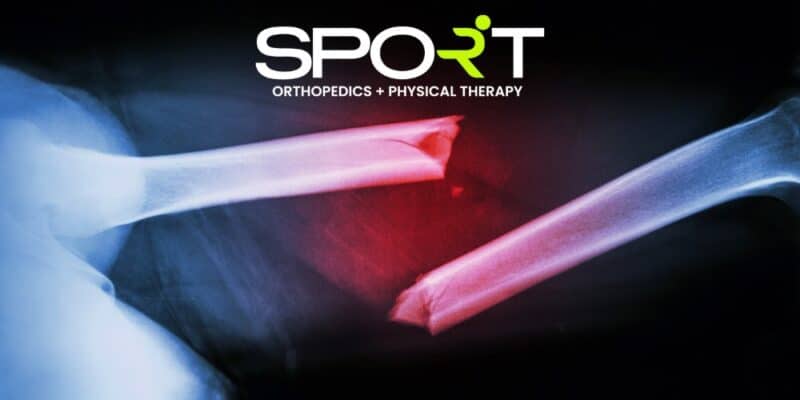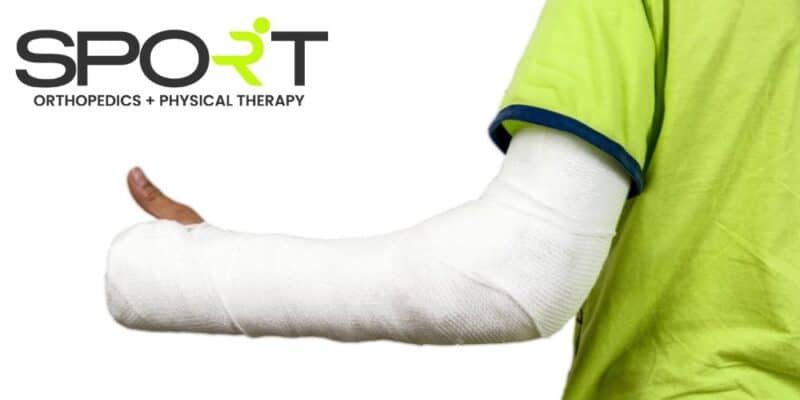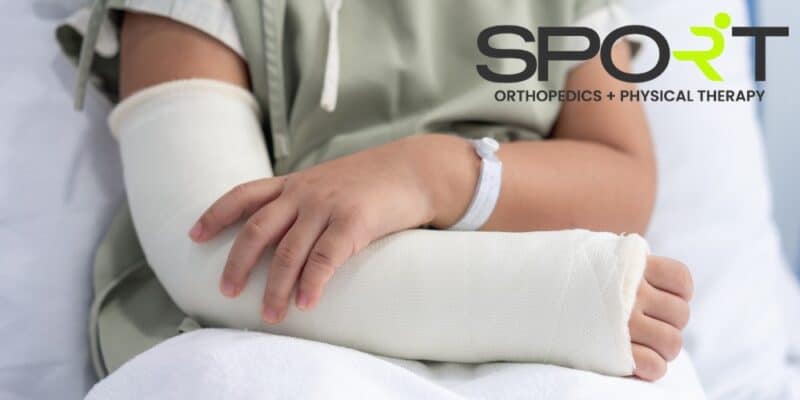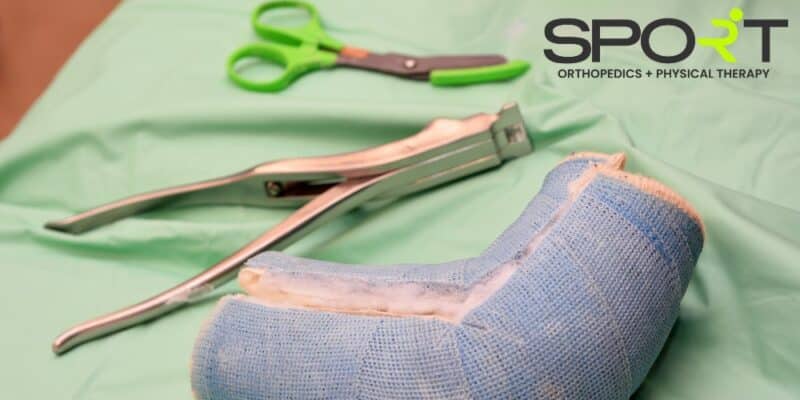Displaced Fracture Treatment in Dallas and Frisco
Treatment for Displaced Fractures, Compound Fractures, Comminuted Fractures
Diagnosis and Treatment for Displaced Fractures
Millions of people suffer from broken bones every year, with men being slightly more at risk of doing so than women. There are several different terms used to describe a broken bone, including comminuted fracture, stress fracture, transverse fracture, oblique fracture, greenstick fracture, open fracture, and displaced fracture. This article focuses on displaced fractures, what they are, how they happen, and how to treat them.
The way in which a bone breaks is important for orthopedic surgeons to understand. Depending on the type of bone fracture, our treatment methods may vary. Displaced fractures, in particular, require prompt treatment and often take a while to heal properly. If you have suffered a broken bone, SPORT Orthopedics + Physical Therapy is here for you. To schedule an appointment with the best Dallas orthopedic surgeons, please call our office at 469-200-2832 today.
If you’re in need of fast, affordable care for your orthopedic injury, pay a visit to our Dallas orthopedic urgent care clinic. We have diagnostic and imaging equipment on-site, which means you can get all the care you need in one convenient location. We also have physical therapists on-site who will help with your recovery. Skip the elevated expenses of emergency rooms and the long wait times of regular urgent care clinics. Contact the orthopedic specialists at SPORT today.
What Is a Displaced Fracture?

A displaced fracture occurs when the bone fractures in a way that leaves a gap around the fracture itself. In other words, the fractured bone has moved out of proper alignment. A displaced fracture can also be described as a closed fracture or open fracture. Closed fractures are those in which the broken bones have not broken through the skin. Open fractures are those in which the broken bones have broken through the skin.
In general, displaced fractures are more complicated than other types of fractures, such as stress fractures or non-displaced fractures. This is because the bone cracks and moves out of alignment, which makes these injuries more likely to require fracture surgery to correct.
Displaced vs Non-Displaced Fracture
Non-displaced fractures differ from displaced fractures in that they do not move the broken bone out of alignment. Even though the bone is still broken, they tend to be less severe fractures than those that are displaced. Additionally, non-displaced fractures are less likely to be open fractures. They may not even break all the way through the bone. For example, maybe the bone cracks, but doesn’t form a break that runs completely through the bone. All broken bones are serious, but some types of fractures are much more serious than others.
If you suspect you have a broken bone, we strongly recommend visiting our orthopaedic surgeons for a proper diagnosis. Waiting too long opens your body up to the risk of the following dangerous complications.
- Bone infection
- Damaged blood vessels
- Bone healed improperly or out of alignment
- Damage to the surrounding tissue
- Permanent deformities
- Long-term joint problems
- Nonunion or delayed union of the bone fracture
Common Causes of Displaced Fractures

Bone fractures can occur in a number of ways, including sudden trauma and gradual wear and tear. Below, we list some of the most common ways in which someone can suffer a broken bone.
- Car accidents
- Falling from heights
- Sudden trauma to the body
- Suffering a direct blow to the bone
- Abuse or physical violence
- Repetitive forces on the body, which often cause stress fractures
Most Common Locations for Displaced Fractures
Certain bones of the body are more susceptible to bone fractures than others. Fractures diagnosed in these areas are more likely for a number of reasons. For example, they may be areas that people fall on more often than other areas. They could also be weaker than other bones. Below, we list the areas of the body where one is more likely to suffer bone breaks.
- Wrists (distal radius fracture)
- Arms (humerus, radius, and ulnar fractures)
- Ankles (tibia, fibula, and talus fractures)
- Hips
- Clavicle (collarbone)
- Fingers
Broken arms are very common, both in adults’ bones and in children’s bones. Hip fractures become more common as we age, especially for those who have osteoporosis.
How Serious Is a Displaced Fracture?
This type of fracture is generally more serious than most other types of fractures, as it is much more likely to require surgery to fix. This is because the bone has been moved out of alignment. They can also cause intense pain that is very difficult for patients to bear. When bones are displaced, they become far less stable. These fractures may also result in the bones being broken into more than two pieces, which can further complicate treatment plans.
Regardless of how serious a bone fracture is, it is imperative that you seek medical attention as soon as possible. Even if you are unsure of whether you’ve broken a bone, it is better to be safe than sorry. Failing to seek treatment for bone fractures can result in serious infections, deformities, and bones healing out of alignment.
Risk Factors for Displaced Fractures

Certain risk factors exist that can make someone more susceptible to broken bones. We list these risk factors below.
- Smoking
- Gender (women are more likely to suffer bone breaks than men)
- Age (children and those over 50 are more likely to break bones)
- Drinking alcohol
- Using steroids (even corticosteroids, which are often used to treat other conditions)
- Rheumatoid arthritis
- Diabetes
- Previous bone fracture
- Certain chronic diseases
- Family history
Symptoms of a Displaced Fracture
Some of the symptoms of a fracture depends on the fracture pattern, but many of the symptoms are the same across all fracture patterns. Whether you have a comminuted fracture, stress fracture, greenstick fracture, closed fracture, compound fracture, or other type of fracture, you are likely to feel significant pain. However, the degree of pain you feel depends on the severity of the fracture. Other symptoms that one can experience when a fracture occurs include the following.
- Visibly misshapen or out of place joints
- Bruising and swelling
- Bleeding
- Tingling or numbness
- Broken skin with the bone poking out
- Inability to use the limb or to bear weight on it
Most fractures are fairly clear to see, but stress fractures or greenstick fractures can be more difficult to discern without an X-ray. If you feel intense pain, see swelling, or suspect a break, see a doctor right away. There is no harm in checking to protect your bone health and mobility.
How Are Displaced Fractures Treated?

When a bone moves out of place, surgeons usually must intervene in order to get the bone back in its proper place. There are two main methods for resetting these fractures: closed reduction and open reduction. In a closed reduction, the doctor resets the bone into its proper position manually, from the outside of the limb. This means that there is no surgery involved.
In an open reduction, the orthopedic surgeon makes incisions in the skin, then uses special surgical instruments to reset the bone. In some cases, the bone will need support and stability from metal plates, screws, pins, wires, and other tools. This is called internal fixation. External fixation occurs when the tools used to keep the bones in place are at least partially located outside the skin.
How Long Does It Take for a Displaced Fracture to Heal?
This largely depends on the severity of the fracture, as well as whether or not the patient has any complications along the way. Most fractures we see will heal within 6 to 8 weeks. However, some fractures can take a slightly shorter amount of time to heal, while others could take much longer. For example, a fracture in your hand might only take six weeks to heal, while a fractured leg bone could take 20 weeks or longer.
We recommend closely following your surgeon’s instructions to ensure that your healing process goes as smoothly as possible. Eat a well-balanced diet, as this encourages health and healing in the body. Some fractures will require total immobilization at the beginning, while others require light weight-bearing exercises. Refrain from smoking during your recovery period, and avoid high doses of NSAIDs. Both of these can inhibit your body’s ability to heal itself.
Can a Displaced Bone Heal Without Surgery?

In some cases, yes. When your doctor resets your bone without making an incision, this is called a closed reduction. If there is no need for surgery, you will likely need to wear a cast or a brace while your bone heals back into place. However, more severe fractures often require surgery and an open reduction. The best way to determine the right course of action for your broken bone is to visit an orthopedic specialist.
A trained orthopedic surgeon can evaluate your break, run the appropriate tests, and formulate a personalized treatment plan that applies specifically to your injury. Not all patients will need surgery, but it isn’t always out of the cards either.
Contact SPORT Orthopedics + Physical Therapy Today
At SPORT Orthopedics + Physical Therapy, we understand how painful and frustrating a broken bone can be. It can take you out of the game and put you on the sidelines for weeks, if not months. We’re here to help you overcome your injury and give you the plan you need to heal properly. Not only do we perform surgical treatments, we also offer Dallas physical therapy to assist our patients with their recovery. Especially after a completely immobilized break, the muscles can atrophy due to lack of use. Physical therapy is a surefire way to counteract this atrophy during your recovery period. To schedule an appointment with one of our orthopedic specialists or physical therapists in Dallas, please call our office at 469-200-2832 today.


